Report: Advanced Financial Accounting Analysis, T1 2019, Holmes
VerifiedAdded on 2023/03/30
|14
|3005
|488
Report
AI Summary
This report provides a detailed analysis of advanced financial accounting principles, policies, and conceptual frameworks. It uses Domain Holdings Australia as a case study to illustrate the application of various accounting concepts, including accrual, full disclosure, matching, conservatism, business entity, and materiality. The report examines the company's compliance with the Corporation Act 2001 and Australian Accounting Standards Board (AASB) standards, focusing on issues related to intangible assets, financial instruments, and impairment. It also explores the conceptual framework, its qualitative characteristics, and its influence on accounting practice. The analysis covers the measurement of assets and liabilities, the recognition of revenue and expenses, and the company's approach to risk management, providing insights into how accounting standards are applied in practice and identifying areas of non-compliance. The report concludes with an overview of the issues identified and the importance of a strong conceptual framework for ensuring consistent and reliable financial reporting.
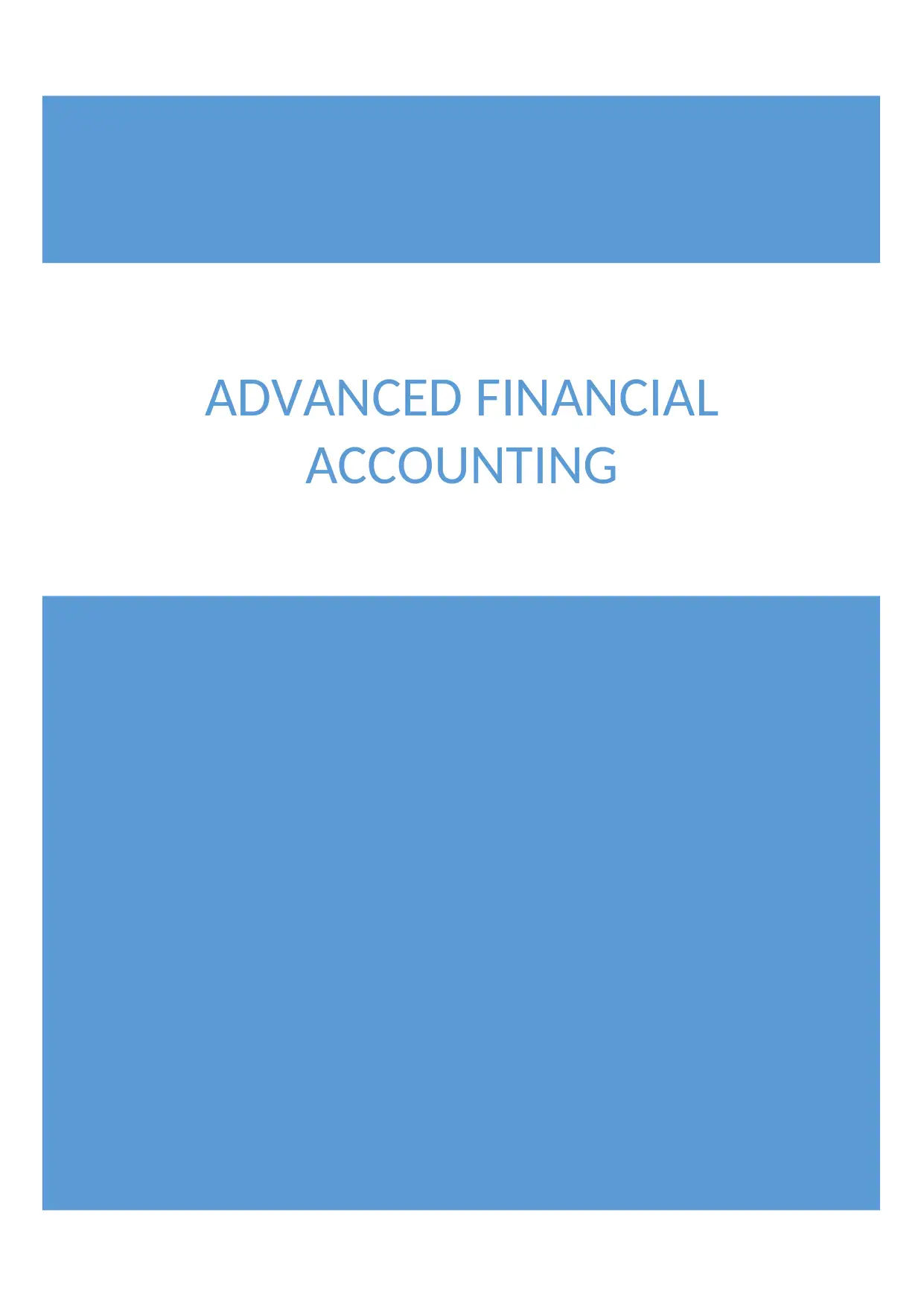
ADVANCED FINANCIAL
ACCOUNTING
ACCOUNTING
Paraphrase This Document
Need a fresh take? Get an instant paraphrase of this document with our AI Paraphraser
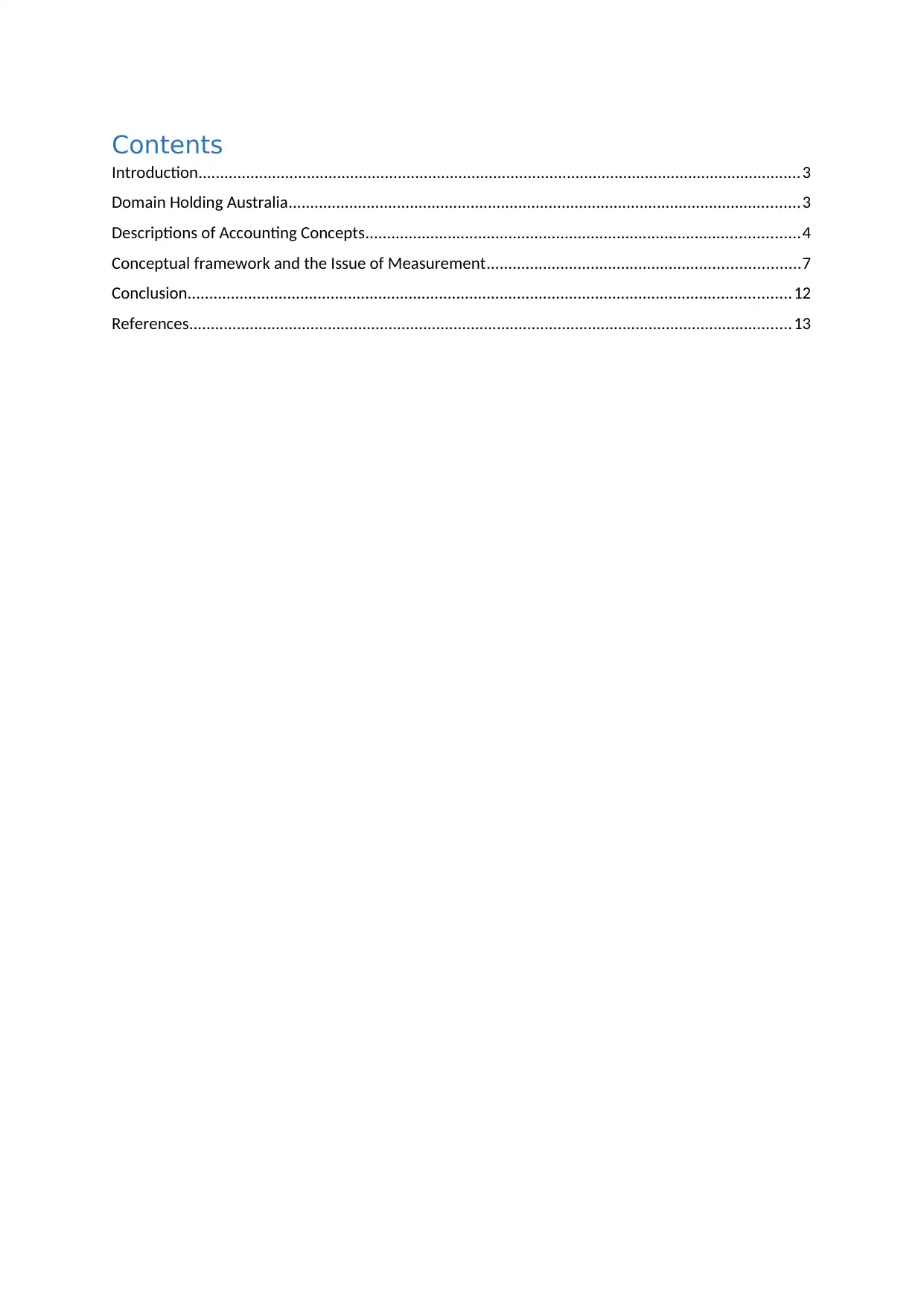
Contents
Introduction...........................................................................................................................................3
Domain Holding Australia......................................................................................................................3
Descriptions of Accounting Concepts....................................................................................................4
Conceptual framework and the Issue of Measurement........................................................................7
Conclusion...........................................................................................................................................12
References...........................................................................................................................................13
Introduction...........................................................................................................................................3
Domain Holding Australia......................................................................................................................3
Descriptions of Accounting Concepts....................................................................................................4
Conceptual framework and the Issue of Measurement........................................................................7
Conclusion...........................................................................................................................................12
References...........................................................................................................................................13
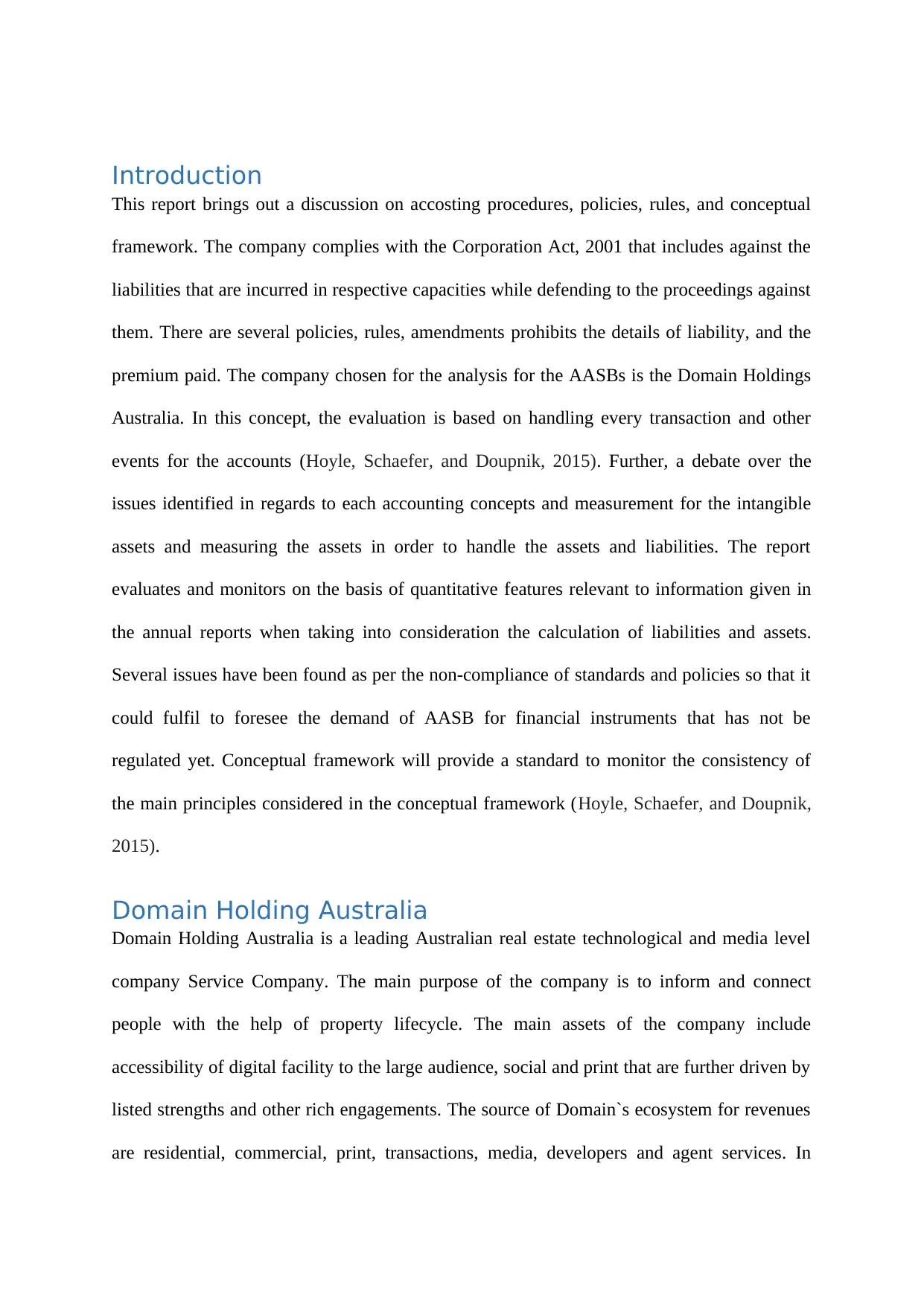
Introduction
This report brings out a discussion on accosting procedures, policies, rules, and conceptual
framework. The company complies with the Corporation Act, 2001 that includes against the
liabilities that are incurred in respective capacities while defending to the proceedings against
them. There are several policies, rules, amendments prohibits the details of liability, and the
premium paid. The company chosen for the analysis for the AASBs is the Domain Holdings
Australia. In this concept, the evaluation is based on handling every transaction and other
events for the accounts (Hoyle, Schaefer, and Doupnik, 2015). Further, a debate over the
issues identified in regards to each accounting concepts and measurement for the intangible
assets and measuring the assets in order to handle the assets and liabilities. The report
evaluates and monitors on the basis of quantitative features relevant to information given in
the annual reports when taking into consideration the calculation of liabilities and assets.
Several issues have been found as per the non-compliance of standards and policies so that it
could fulfil to foresee the demand of AASB for financial instruments that has not be
regulated yet. Conceptual framework will provide a standard to monitor the consistency of
the main principles considered in the conceptual framework (Hoyle, Schaefer, and Doupnik,
2015).
Domain Holding Australia
Domain Holding Australia is a leading Australian real estate technological and media level
company Service Company. The main purpose of the company is to inform and connect
people with the help of property lifecycle. The main assets of the company include
accessibility of digital facility to the large audience, social and print that are further driven by
listed strengths and other rich engagements. The source of Domain`s ecosystem for revenues
are residential, commercial, print, transactions, media, developers and agent services. In
This report brings out a discussion on accosting procedures, policies, rules, and conceptual
framework. The company complies with the Corporation Act, 2001 that includes against the
liabilities that are incurred in respective capacities while defending to the proceedings against
them. There are several policies, rules, amendments prohibits the details of liability, and the
premium paid. The company chosen for the analysis for the AASBs is the Domain Holdings
Australia. In this concept, the evaluation is based on handling every transaction and other
events for the accounts (Hoyle, Schaefer, and Doupnik, 2015). Further, a debate over the
issues identified in regards to each accounting concepts and measurement for the intangible
assets and measuring the assets in order to handle the assets and liabilities. The report
evaluates and monitors on the basis of quantitative features relevant to information given in
the annual reports when taking into consideration the calculation of liabilities and assets.
Several issues have been found as per the non-compliance of standards and policies so that it
could fulfil to foresee the demand of AASB for financial instruments that has not be
regulated yet. Conceptual framework will provide a standard to monitor the consistency of
the main principles considered in the conceptual framework (Hoyle, Schaefer, and Doupnik,
2015).
Domain Holding Australia
Domain Holding Australia is a leading Australian real estate technological and media level
company Service Company. The main purpose of the company is to inform and connect
people with the help of property lifecycle. The main assets of the company include
accessibility of digital facility to the large audience, social and print that are further driven by
listed strengths and other rich engagements. The source of Domain`s ecosystem for revenues
are residential, commercial, print, transactions, media, developers and agent services. In
⊘ This is a preview!⊘
Do you want full access?
Subscribe today to unlock all pages.

Trusted by 1+ million students worldwide
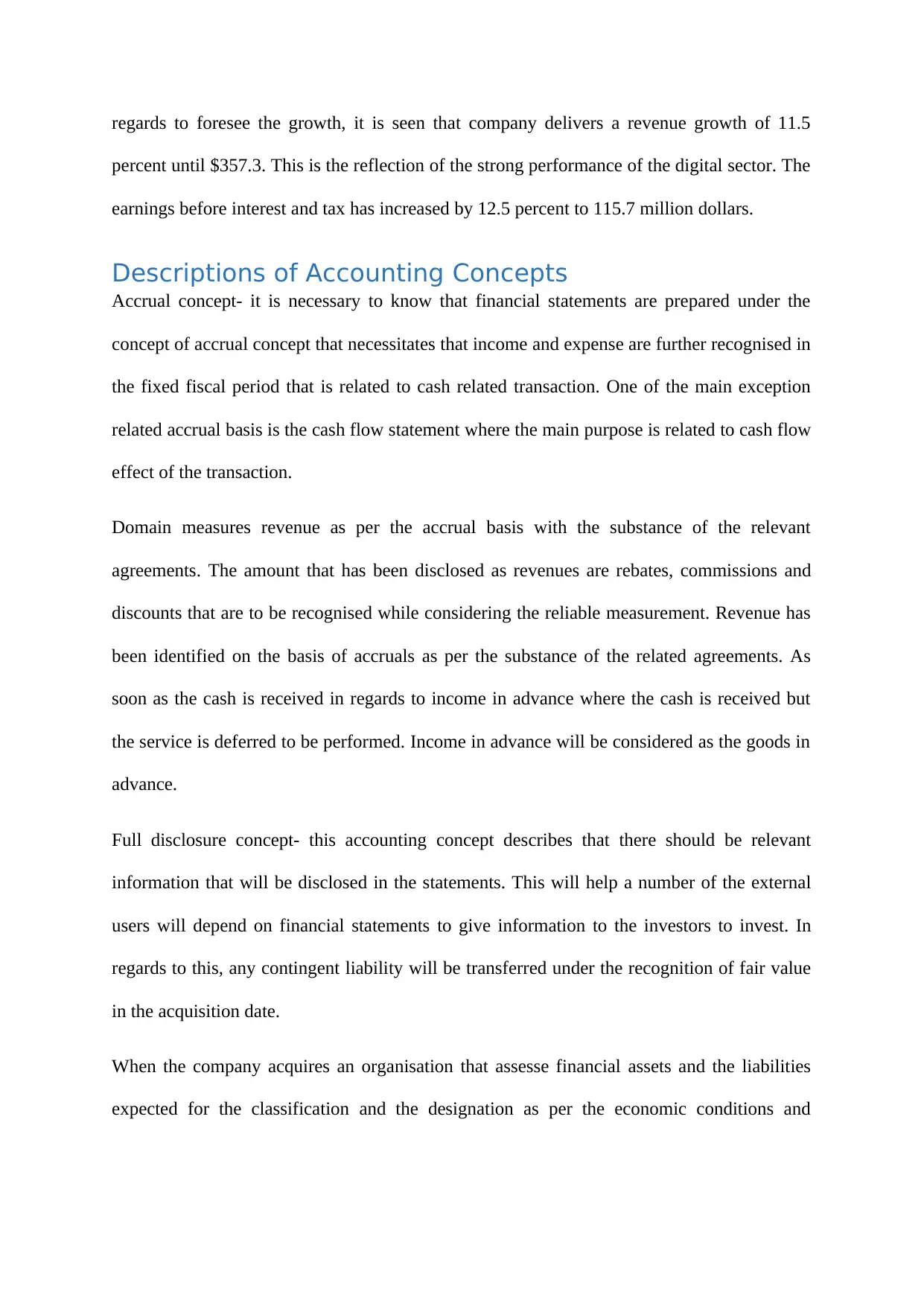
regards to foresee the growth, it is seen that company delivers a revenue growth of 11.5
percent until $357.3. This is the reflection of the strong performance of the digital sector. The
earnings before interest and tax has increased by 12.5 percent to 115.7 million dollars.
Descriptions of Accounting Concepts
Accrual concept- it is necessary to know that financial statements are prepared under the
concept of accrual concept that necessitates that income and expense are further recognised in
the fixed fiscal period that is related to cash related transaction. One of the main exception
related accrual basis is the cash flow statement where the main purpose is related to cash flow
effect of the transaction.
Domain measures revenue as per the accrual basis with the substance of the relevant
agreements. The amount that has been disclosed as revenues are rebates, commissions and
discounts that are to be recognised while considering the reliable measurement. Revenue has
been identified on the basis of accruals as per the substance of the related agreements. As
soon as the cash is received in regards to income in advance where the cash is received but
the service is deferred to be performed. Income in advance will be considered as the goods in
advance.
Full disclosure concept- this accounting concept describes that there should be relevant
information that will be disclosed in the statements. This will help a number of the external
users will depend on financial statements to give information to the investors to invest. In
regards to this, any contingent liability will be transferred under the recognition of fair value
in the acquisition date.
When the company acquires an organisation that assesse financial assets and the liabilities
expected for the classification and the designation as per the economic conditions and
percent until $357.3. This is the reflection of the strong performance of the digital sector. The
earnings before interest and tax has increased by 12.5 percent to 115.7 million dollars.
Descriptions of Accounting Concepts
Accrual concept- it is necessary to know that financial statements are prepared under the
concept of accrual concept that necessitates that income and expense are further recognised in
the fixed fiscal period that is related to cash related transaction. One of the main exception
related accrual basis is the cash flow statement where the main purpose is related to cash flow
effect of the transaction.
Domain measures revenue as per the accrual basis with the substance of the relevant
agreements. The amount that has been disclosed as revenues are rebates, commissions and
discounts that are to be recognised while considering the reliable measurement. Revenue has
been identified on the basis of accruals as per the substance of the related agreements. As
soon as the cash is received in regards to income in advance where the cash is received but
the service is deferred to be performed. Income in advance will be considered as the goods in
advance.
Full disclosure concept- this accounting concept describes that there should be relevant
information that will be disclosed in the statements. This will help a number of the external
users will depend on financial statements to give information to the investors to invest. In
regards to this, any contingent liability will be transferred under the recognition of fair value
in the acquisition date.
When the company acquires an organisation that assesse financial assets and the liabilities
expected for the classification and the designation as per the economic conditions and
Paraphrase This Document
Need a fresh take? Get an instant paraphrase of this document with our AI Paraphraser
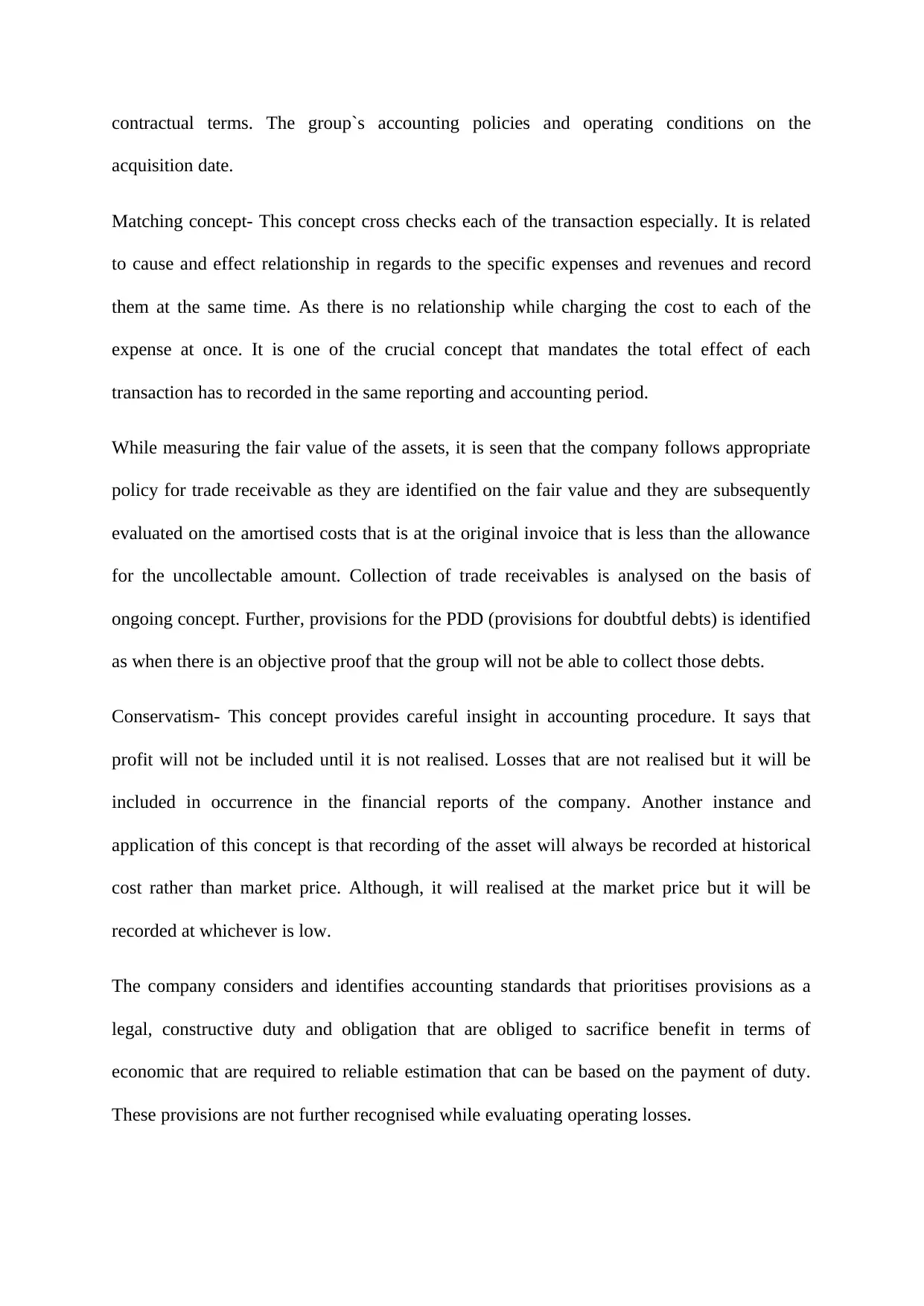
contractual terms. The group`s accounting policies and operating conditions on the
acquisition date.
Matching concept- This concept cross checks each of the transaction especially. It is related
to cause and effect relationship in regards to the specific expenses and revenues and record
them at the same time. As there is no relationship while charging the cost to each of the
expense at once. It is one of the crucial concept that mandates the total effect of each
transaction has to recorded in the same reporting and accounting period.
While measuring the fair value of the assets, it is seen that the company follows appropriate
policy for trade receivable as they are identified on the fair value and they are subsequently
evaluated on the amortised costs that is at the original invoice that is less than the allowance
for the uncollectable amount. Collection of trade receivables is analysed on the basis of
ongoing concept. Further, provisions for the PDD (provisions for doubtful debts) is identified
as when there is an objective proof that the group will not be able to collect those debts.
Conservatism- This concept provides careful insight in accounting procedure. It says that
profit will not be included until it is not realised. Losses that are not realised but it will be
included in occurrence in the financial reports of the company. Another instance and
application of this concept is that recording of the asset will always be recorded at historical
cost rather than market price. Although, it will realised at the market price but it will be
recorded at whichever is low.
The company considers and identifies accounting standards that prioritises provisions as a
legal, constructive duty and obligation that are obliged to sacrifice benefit in terms of
economic that are required to reliable estimation that can be based on the payment of duty.
These provisions are not further recognised while evaluating operating losses.
acquisition date.
Matching concept- This concept cross checks each of the transaction especially. It is related
to cause and effect relationship in regards to the specific expenses and revenues and record
them at the same time. As there is no relationship while charging the cost to each of the
expense at once. It is one of the crucial concept that mandates the total effect of each
transaction has to recorded in the same reporting and accounting period.
While measuring the fair value of the assets, it is seen that the company follows appropriate
policy for trade receivable as they are identified on the fair value and they are subsequently
evaluated on the amortised costs that is at the original invoice that is less than the allowance
for the uncollectable amount. Collection of trade receivables is analysed on the basis of
ongoing concept. Further, provisions for the PDD (provisions for doubtful debts) is identified
as when there is an objective proof that the group will not be able to collect those debts.
Conservatism- This concept provides careful insight in accounting procedure. It says that
profit will not be included until it is not realised. Losses that are not realised but it will be
included in occurrence in the financial reports of the company. Another instance and
application of this concept is that recording of the asset will always be recorded at historical
cost rather than market price. Although, it will realised at the market price but it will be
recorded at whichever is low.
The company considers and identifies accounting standards that prioritises provisions as a
legal, constructive duty and obligation that are obliged to sacrifice benefit in terms of
economic that are required to reliable estimation that can be based on the payment of duty.
These provisions are not further recognised while evaluating operating losses.
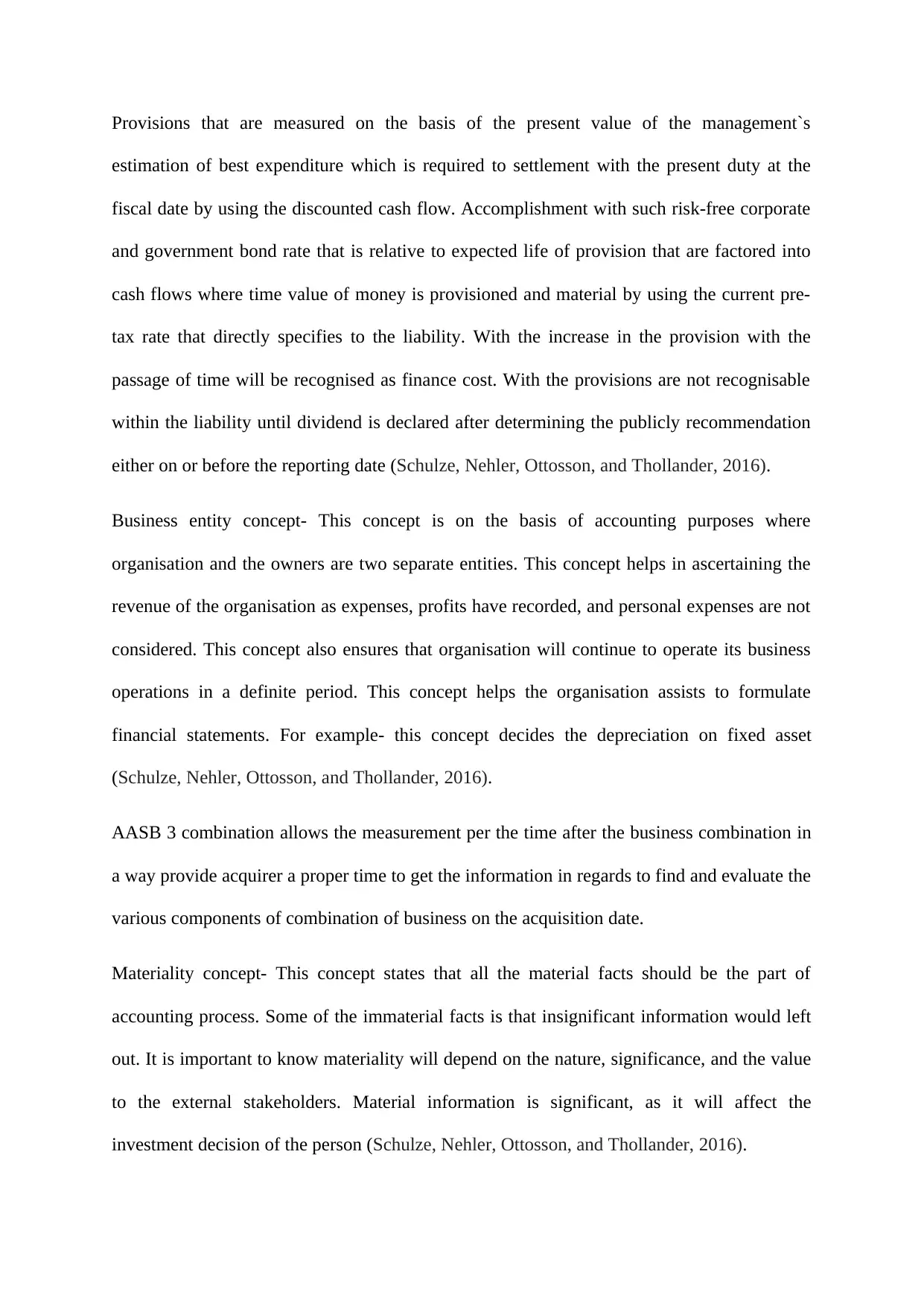
Provisions that are measured on the basis of the present value of the management`s
estimation of best expenditure which is required to settlement with the present duty at the
fiscal date by using the discounted cash flow. Accomplishment with such risk-free corporate
and government bond rate that is relative to expected life of provision that are factored into
cash flows where time value of money is provisioned and material by using the current pre-
tax rate that directly specifies to the liability. With the increase in the provision with the
passage of time will be recognised as finance cost. With the provisions are not recognisable
within the liability until dividend is declared after determining the publicly recommendation
either on or before the reporting date (Schulze, Nehler, Ottosson, and Thollander, 2016).
Business entity concept- This concept is on the basis of accounting purposes where
organisation and the owners are two separate entities. This concept helps in ascertaining the
revenue of the organisation as expenses, profits have recorded, and personal expenses are not
considered. This concept also ensures that organisation will continue to operate its business
operations in a definite period. This concept helps the organisation assists to formulate
financial statements. For example- this concept decides the depreciation on fixed asset
(Schulze, Nehler, Ottosson, and Thollander, 2016).
AASB 3 combination allows the measurement per the time after the business combination in
a way provide acquirer a proper time to get the information in regards to find and evaluate the
various components of combination of business on the acquisition date.
Materiality concept- This concept states that all the material facts should be the part of
accounting process. Some of the immaterial facts is that insignificant information would left
out. It is important to know materiality will depend on the nature, significance, and the value
to the external stakeholders. Material information is significant, as it will affect the
investment decision of the person (Schulze, Nehler, Ottosson, and Thollander, 2016).
estimation of best expenditure which is required to settlement with the present duty at the
fiscal date by using the discounted cash flow. Accomplishment with such risk-free corporate
and government bond rate that is relative to expected life of provision that are factored into
cash flows where time value of money is provisioned and material by using the current pre-
tax rate that directly specifies to the liability. With the increase in the provision with the
passage of time will be recognised as finance cost. With the provisions are not recognisable
within the liability until dividend is declared after determining the publicly recommendation
either on or before the reporting date (Schulze, Nehler, Ottosson, and Thollander, 2016).
Business entity concept- This concept is on the basis of accounting purposes where
organisation and the owners are two separate entities. This concept helps in ascertaining the
revenue of the organisation as expenses, profits have recorded, and personal expenses are not
considered. This concept also ensures that organisation will continue to operate its business
operations in a definite period. This concept helps the organisation assists to formulate
financial statements. For example- this concept decides the depreciation on fixed asset
(Schulze, Nehler, Ottosson, and Thollander, 2016).
AASB 3 combination allows the measurement per the time after the business combination in
a way provide acquirer a proper time to get the information in regards to find and evaluate the
various components of combination of business on the acquisition date.
Materiality concept- This concept states that all the material facts should be the part of
accounting process. Some of the immaterial facts is that insignificant information would left
out. It is important to know materiality will depend on the nature, significance, and the value
to the external stakeholders. Material information is significant, as it will affect the
investment decision of the person (Schulze, Nehler, Ottosson, and Thollander, 2016).
⊘ This is a preview!⊘
Do you want full access?
Subscribe today to unlock all pages.

Trusted by 1+ million students worldwide
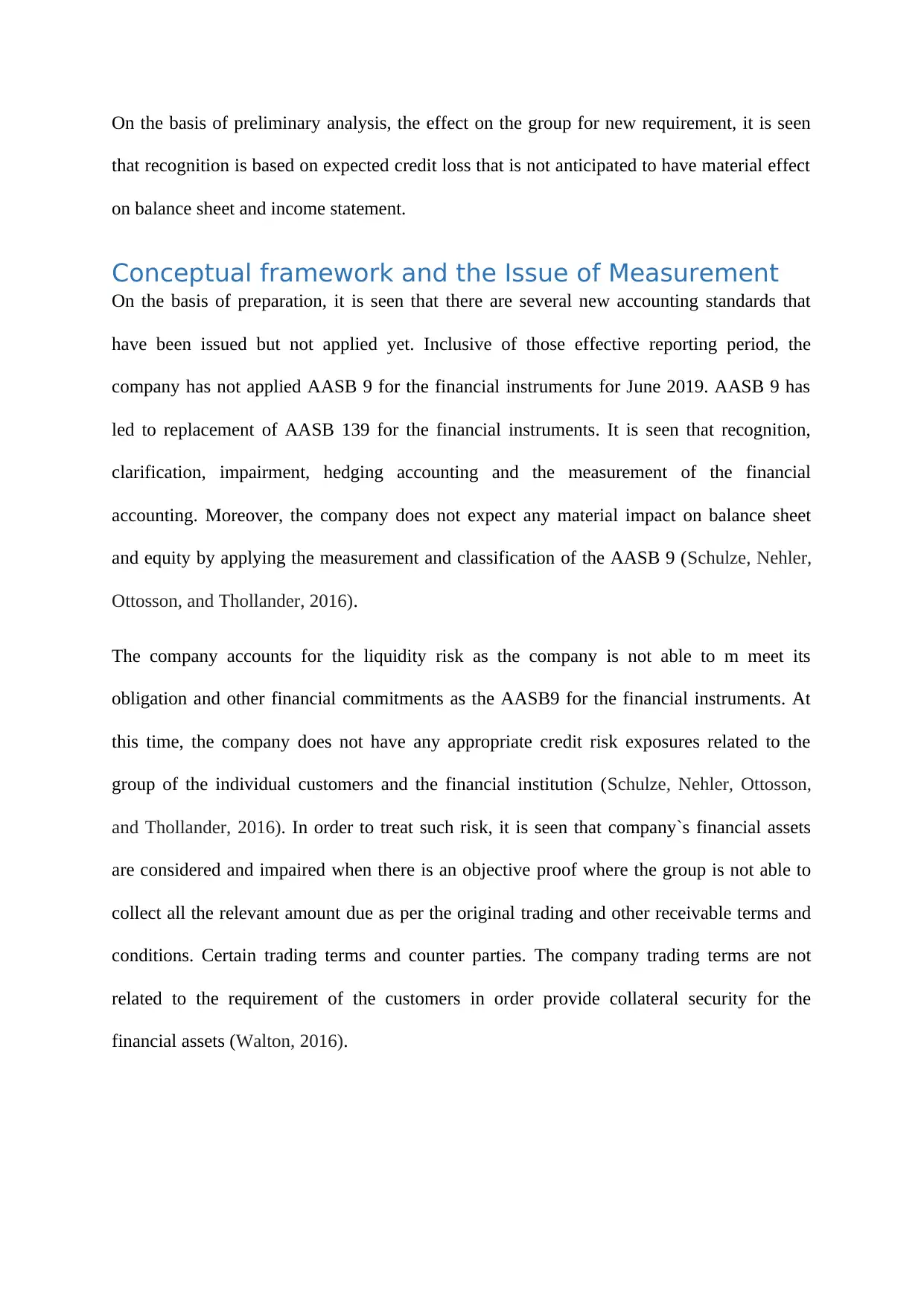
On the basis of preliminary analysis, the effect on the group for new requirement, it is seen
that recognition is based on expected credit loss that is not anticipated to have material effect
on balance sheet and income statement.
Conceptual framework and the Issue of Measurement
On the basis of preparation, it is seen that there are several new accounting standards that
have been issued but not applied yet. Inclusive of those effective reporting period, the
company has not applied AASB 9 for the financial instruments for June 2019. AASB 9 has
led to replacement of AASB 139 for the financial instruments. It is seen that recognition,
clarification, impairment, hedging accounting and the measurement of the financial
accounting. Moreover, the company does not expect any material impact on balance sheet
and equity by applying the measurement and classification of the AASB 9 (Schulze, Nehler,
Ottosson, and Thollander, 2016).
The company accounts for the liquidity risk as the company is not able to m meet its
obligation and other financial commitments as the AASB9 for the financial instruments. At
this time, the company does not have any appropriate credit risk exposures related to the
group of the individual customers and the financial institution (Schulze, Nehler, Ottosson,
and Thollander, 2016). In order to treat such risk, it is seen that company`s financial assets
are considered and impaired when there is an objective proof where the group is not able to
collect all the relevant amount due as per the original trading and other receivable terms and
conditions. Certain trading terms and counter parties. The company trading terms are not
related to the requirement of the customers in order provide collateral security for the
financial assets (Walton, 2016).
that recognition is based on expected credit loss that is not anticipated to have material effect
on balance sheet and income statement.
Conceptual framework and the Issue of Measurement
On the basis of preparation, it is seen that there are several new accounting standards that
have been issued but not applied yet. Inclusive of those effective reporting period, the
company has not applied AASB 9 for the financial instruments for June 2019. AASB 9 has
led to replacement of AASB 139 for the financial instruments. It is seen that recognition,
clarification, impairment, hedging accounting and the measurement of the financial
accounting. Moreover, the company does not expect any material impact on balance sheet
and equity by applying the measurement and classification of the AASB 9 (Schulze, Nehler,
Ottosson, and Thollander, 2016).
The company accounts for the liquidity risk as the company is not able to m meet its
obligation and other financial commitments as the AASB9 for the financial instruments. At
this time, the company does not have any appropriate credit risk exposures related to the
group of the individual customers and the financial institution (Schulze, Nehler, Ottosson,
and Thollander, 2016). In order to treat such risk, it is seen that company`s financial assets
are considered and impaired when there is an objective proof where the group is not able to
collect all the relevant amount due as per the original trading and other receivable terms and
conditions. Certain trading terms and counter parties. The company trading terms are not
related to the requirement of the customers in order provide collateral security for the
financial assets (Walton, 2016).
Paraphrase This Document
Need a fresh take? Get an instant paraphrase of this document with our AI Paraphraser
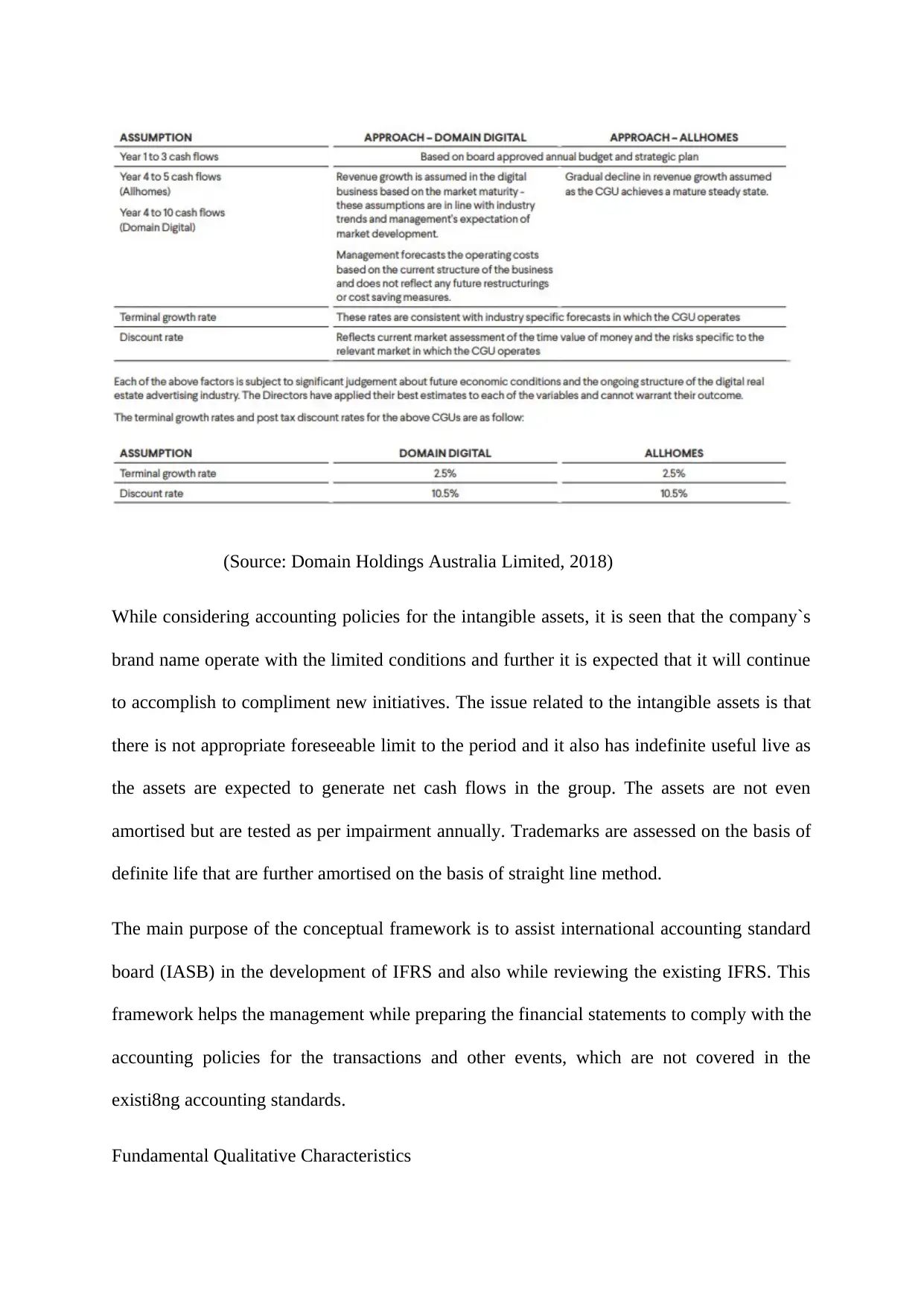
(Source: Domain Holdings Australia Limited, 2018)
While considering accounting policies for the intangible assets, it is seen that the company`s
brand name operate with the limited conditions and further it is expected that it will continue
to accomplish to compliment new initiatives. The issue related to the intangible assets is that
there is not appropriate foreseeable limit to the period and it also has indefinite useful live as
the assets are expected to generate net cash flows in the group. The assets are not even
amortised but are tested as per impairment annually. Trademarks are assessed on the basis of
definite life that are further amortised on the basis of straight line method.
The main purpose of the conceptual framework is to assist international accounting standard
board (IASB) in the development of IFRS and also while reviewing the existing IFRS. This
framework helps the management while preparing the financial statements to comply with the
accounting policies for the transactions and other events, which are not covered in the
existi8ng accounting standards.
Fundamental Qualitative Characteristics
While considering accounting policies for the intangible assets, it is seen that the company`s
brand name operate with the limited conditions and further it is expected that it will continue
to accomplish to compliment new initiatives. The issue related to the intangible assets is that
there is not appropriate foreseeable limit to the period and it also has indefinite useful live as
the assets are expected to generate net cash flows in the group. The assets are not even
amortised but are tested as per impairment annually. Trademarks are assessed on the basis of
definite life that are further amortised on the basis of straight line method.
The main purpose of the conceptual framework is to assist international accounting standard
board (IASB) in the development of IFRS and also while reviewing the existing IFRS. This
framework helps the management while preparing the financial statements to comply with the
accounting policies for the transactions and other events, which are not covered in the
existi8ng accounting standards.
Fundamental Qualitative Characteristics
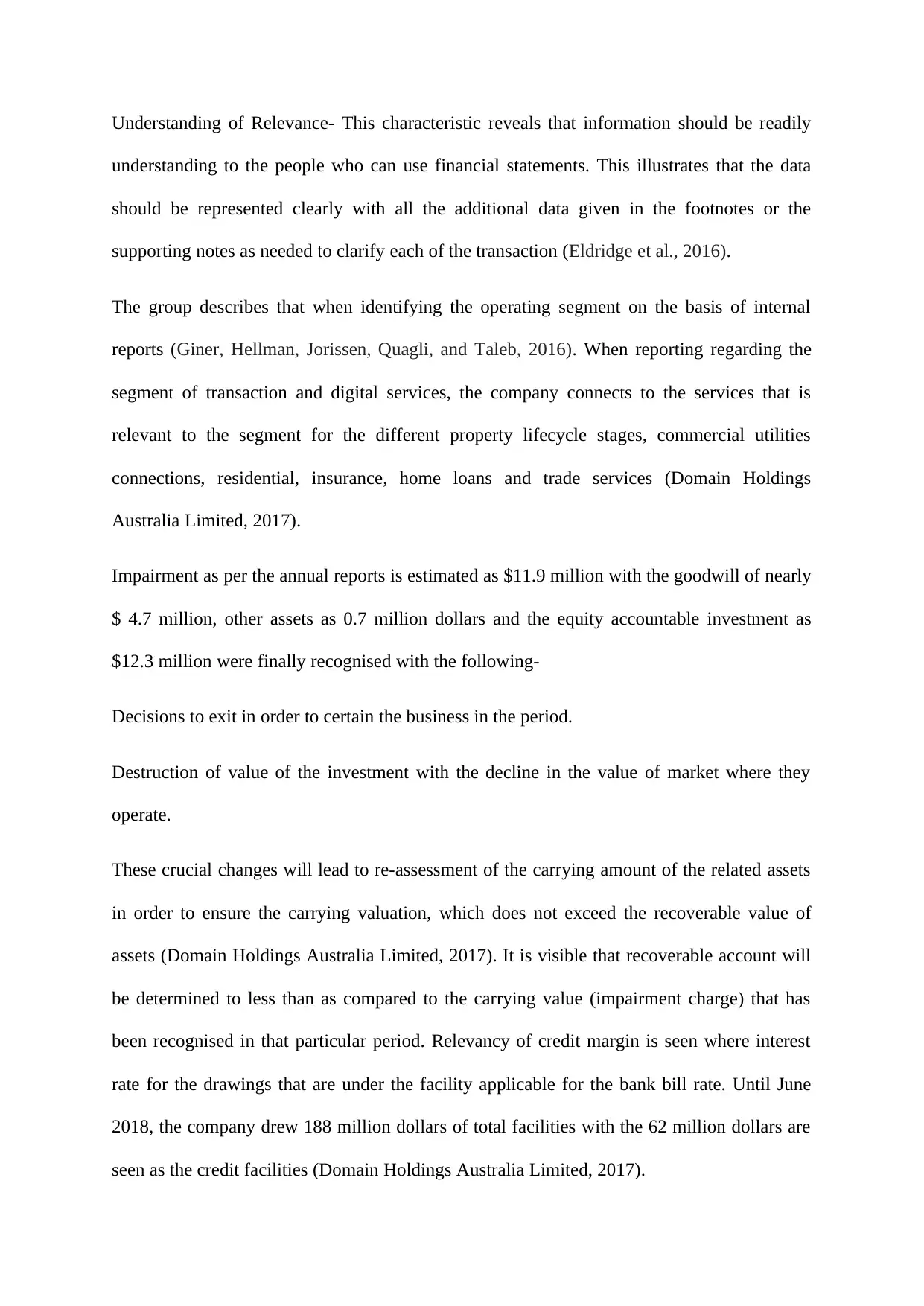
Understanding of Relevance- This characteristic reveals that information should be readily
understanding to the people who can use financial statements. This illustrates that the data
should be represented clearly with all the additional data given in the footnotes or the
supporting notes as needed to clarify each of the transaction (Eldridge et al., 2016).
The group describes that when identifying the operating segment on the basis of internal
reports (Giner, Hellman, Jorissen, Quagli, and Taleb, 2016). When reporting regarding the
segment of transaction and digital services, the company connects to the services that is
relevant to the segment for the different property lifecycle stages, commercial utilities
connections, residential, insurance, home loans and trade services (Domain Holdings
Australia Limited, 2017).
Impairment as per the annual reports is estimated as $11.9 million with the goodwill of nearly
$ 4.7 million, other assets as 0.7 million dollars and the equity accountable investment as
$12.3 million were finally recognised with the following-
Decisions to exit in order to certain the business in the period.
Destruction of value of the investment with the decline in the value of market where they
operate.
These crucial changes will lead to re-assessment of the carrying amount of the related assets
in order to ensure the carrying valuation, which does not exceed the recoverable value of
assets (Domain Holdings Australia Limited, 2017). It is visible that recoverable account will
be determined to less than as compared to the carrying value (impairment charge) that has
been recognised in that particular period. Relevancy of credit margin is seen where interest
rate for the drawings that are under the facility applicable for the bank bill rate. Until June
2018, the company drew 188 million dollars of total facilities with the 62 million dollars are
seen as the credit facilities (Domain Holdings Australia Limited, 2017).
understanding to the people who can use financial statements. This illustrates that the data
should be represented clearly with all the additional data given in the footnotes or the
supporting notes as needed to clarify each of the transaction (Eldridge et al., 2016).
The group describes that when identifying the operating segment on the basis of internal
reports (Giner, Hellman, Jorissen, Quagli, and Taleb, 2016). When reporting regarding the
segment of transaction and digital services, the company connects to the services that is
relevant to the segment for the different property lifecycle stages, commercial utilities
connections, residential, insurance, home loans and trade services (Domain Holdings
Australia Limited, 2017).
Impairment as per the annual reports is estimated as $11.9 million with the goodwill of nearly
$ 4.7 million, other assets as 0.7 million dollars and the equity accountable investment as
$12.3 million were finally recognised with the following-
Decisions to exit in order to certain the business in the period.
Destruction of value of the investment with the decline in the value of market where they
operate.
These crucial changes will lead to re-assessment of the carrying amount of the related assets
in order to ensure the carrying valuation, which does not exceed the recoverable value of
assets (Domain Holdings Australia Limited, 2017). It is visible that recoverable account will
be determined to less than as compared to the carrying value (impairment charge) that has
been recognised in that particular period. Relevancy of credit margin is seen where interest
rate for the drawings that are under the facility applicable for the bank bill rate. Until June
2018, the company drew 188 million dollars of total facilities with the 62 million dollars are
seen as the credit facilities (Domain Holdings Australia Limited, 2017).
⊘ This is a preview!⊘
Do you want full access?
Subscribe today to unlock all pages.

Trusted by 1+ million students worldwide
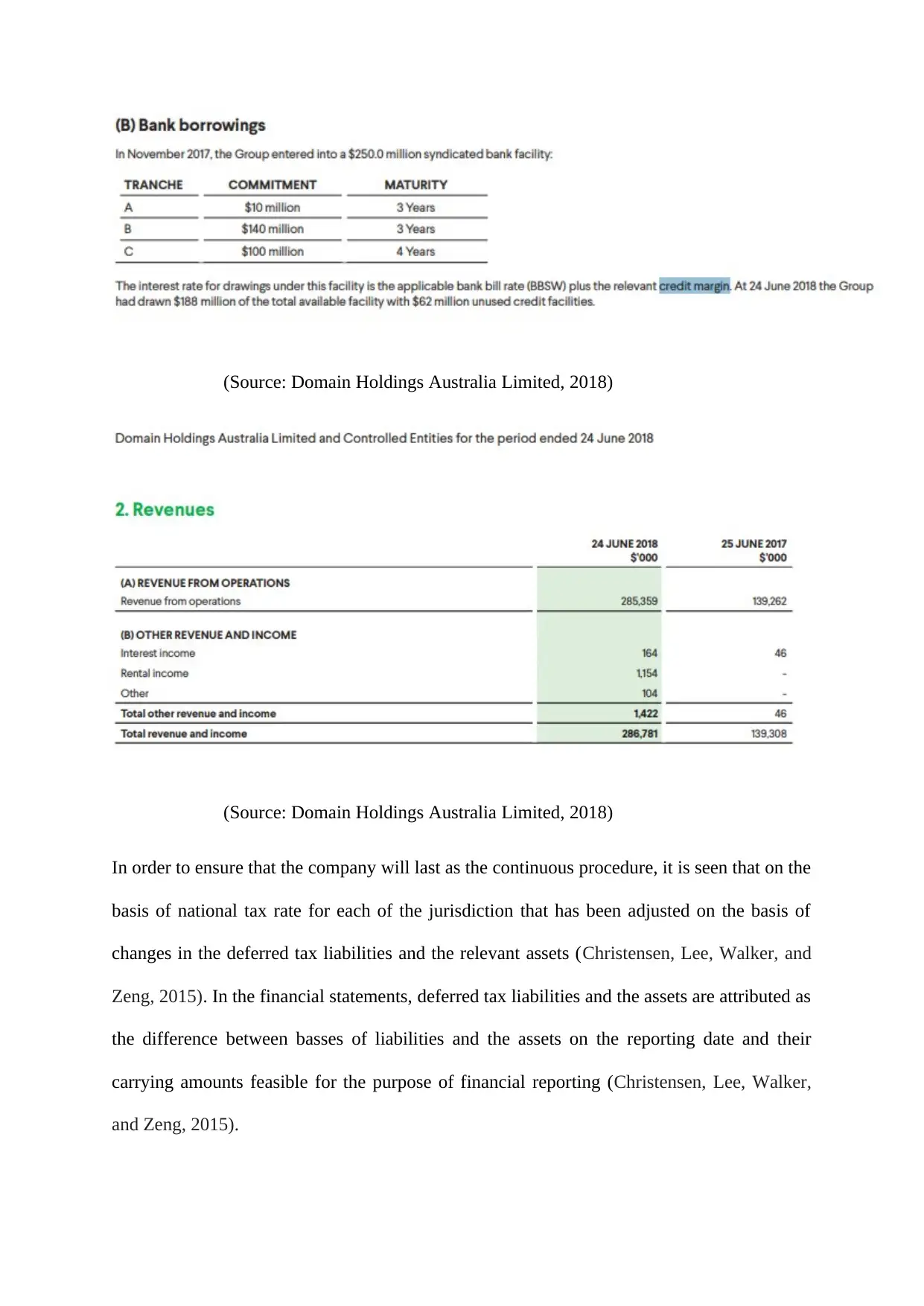
(Source: Domain Holdings Australia Limited, 2018)
(Source: Domain Holdings Australia Limited, 2018)
In order to ensure that the company will last as the continuous procedure, it is seen that on the
basis of national tax rate for each of the jurisdiction that has been adjusted on the basis of
changes in the deferred tax liabilities and the relevant assets (Christensen, Lee, Walker, and
Zeng, 2015). In the financial statements, deferred tax liabilities and the assets are attributed as
the difference between basses of liabilities and the assets on the reporting date and their
carrying amounts feasible for the purpose of financial reporting (Christensen, Lee, Walker,
and Zeng, 2015).
(Source: Domain Holdings Australia Limited, 2018)
In order to ensure that the company will last as the continuous procedure, it is seen that on the
basis of national tax rate for each of the jurisdiction that has been adjusted on the basis of
changes in the deferred tax liabilities and the relevant assets (Christensen, Lee, Walker, and
Zeng, 2015). In the financial statements, deferred tax liabilities and the assets are attributed as
the difference between basses of liabilities and the assets on the reporting date and their
carrying amounts feasible for the purpose of financial reporting (Christensen, Lee, Walker,
and Zeng, 2015).
Paraphrase This Document
Need a fresh take? Get an instant paraphrase of this document with our AI Paraphraser
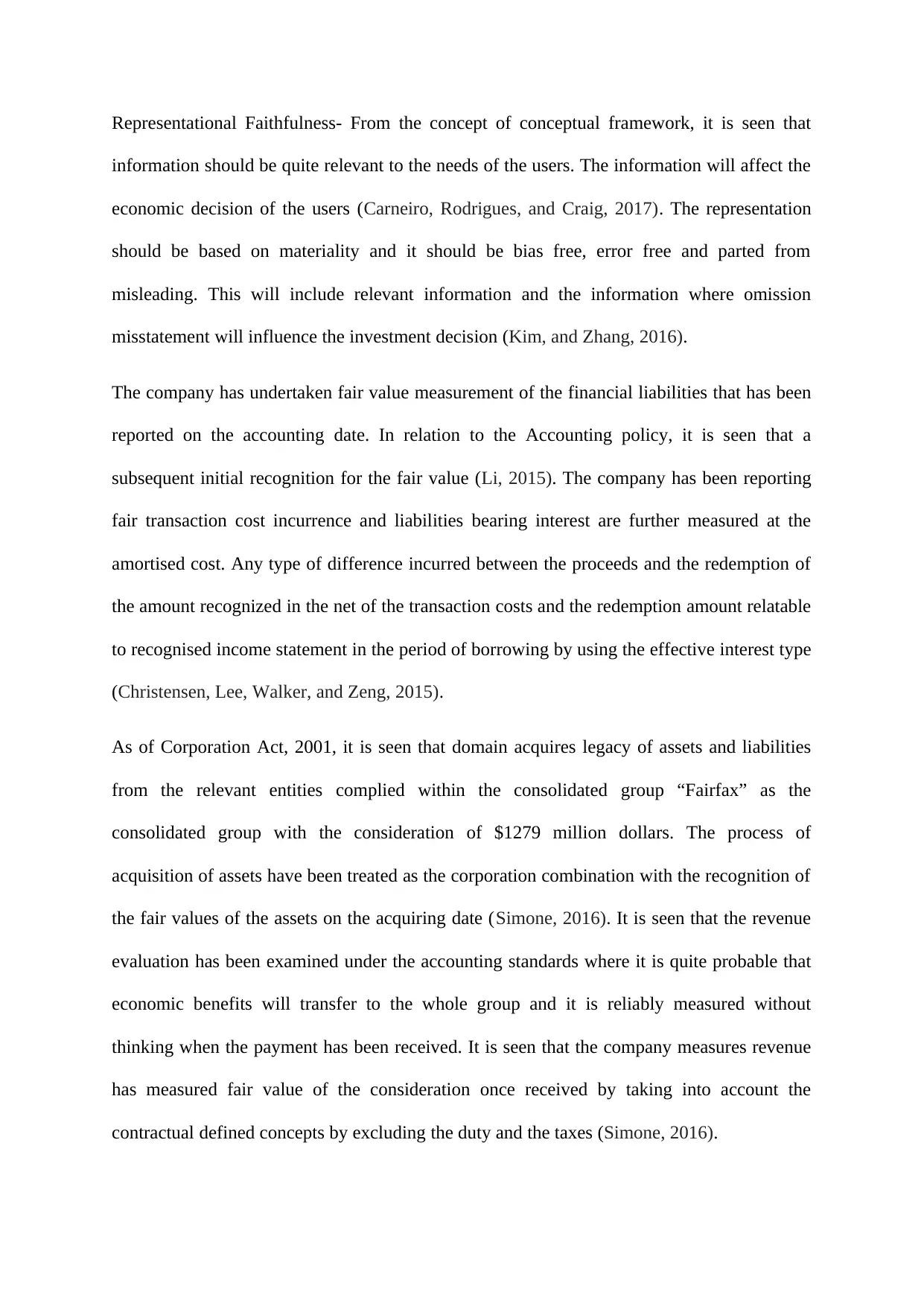
Representational Faithfulness- From the concept of conceptual framework, it is seen that
information should be quite relevant to the needs of the users. The information will affect the
economic decision of the users (Carneiro, Rodrigues, and Craig, 2017). The representation
should be based on materiality and it should be bias free, error free and parted from
misleading. This will include relevant information and the information where omission
misstatement will influence the investment decision (Kim, and Zhang, 2016).
The company has undertaken fair value measurement of the financial liabilities that has been
reported on the accounting date. In relation to the Accounting policy, it is seen that a
subsequent initial recognition for the fair value (Li, 2015). The company has been reporting
fair transaction cost incurrence and liabilities bearing interest are further measured at the
amortised cost. Any type of difference incurred between the proceeds and the redemption of
the amount recognized in the net of the transaction costs and the redemption amount relatable
to recognised income statement in the period of borrowing by using the effective interest type
(Christensen, Lee, Walker, and Zeng, 2015).
As of Corporation Act, 2001, it is seen that domain acquires legacy of assets and liabilities
from the relevant entities complied within the consolidated group “Fairfax” as the
consolidated group with the consideration of $1279 million dollars. The process of
acquisition of assets have been treated as the corporation combination with the recognition of
the fair values of the assets on the acquiring date (Simone, 2016). It is seen that the revenue
evaluation has been examined under the accounting standards where it is quite probable that
economic benefits will transfer to the whole group and it is reliably measured without
thinking when the payment has been received. It is seen that the company measures revenue
has measured fair value of the consideration once received by taking into account the
contractual defined concepts by excluding the duty and the taxes (Simone, 2016).
information should be quite relevant to the needs of the users. The information will affect the
economic decision of the users (Carneiro, Rodrigues, and Craig, 2017). The representation
should be based on materiality and it should be bias free, error free and parted from
misleading. This will include relevant information and the information where omission
misstatement will influence the investment decision (Kim, and Zhang, 2016).
The company has undertaken fair value measurement of the financial liabilities that has been
reported on the accounting date. In relation to the Accounting policy, it is seen that a
subsequent initial recognition for the fair value (Li, 2015). The company has been reporting
fair transaction cost incurrence and liabilities bearing interest are further measured at the
amortised cost. Any type of difference incurred between the proceeds and the redemption of
the amount recognized in the net of the transaction costs and the redemption amount relatable
to recognised income statement in the period of borrowing by using the effective interest type
(Christensen, Lee, Walker, and Zeng, 2015).
As of Corporation Act, 2001, it is seen that domain acquires legacy of assets and liabilities
from the relevant entities complied within the consolidated group “Fairfax” as the
consolidated group with the consideration of $1279 million dollars. The process of
acquisition of assets have been treated as the corporation combination with the recognition of
the fair values of the assets on the acquiring date (Simone, 2016). It is seen that the revenue
evaluation has been examined under the accounting standards where it is quite probable that
economic benefits will transfer to the whole group and it is reliably measured without
thinking when the payment has been received. It is seen that the company measures revenue
has measured fair value of the consideration once received by taking into account the
contractual defined concepts by excluding the duty and the taxes (Simone, 2016).
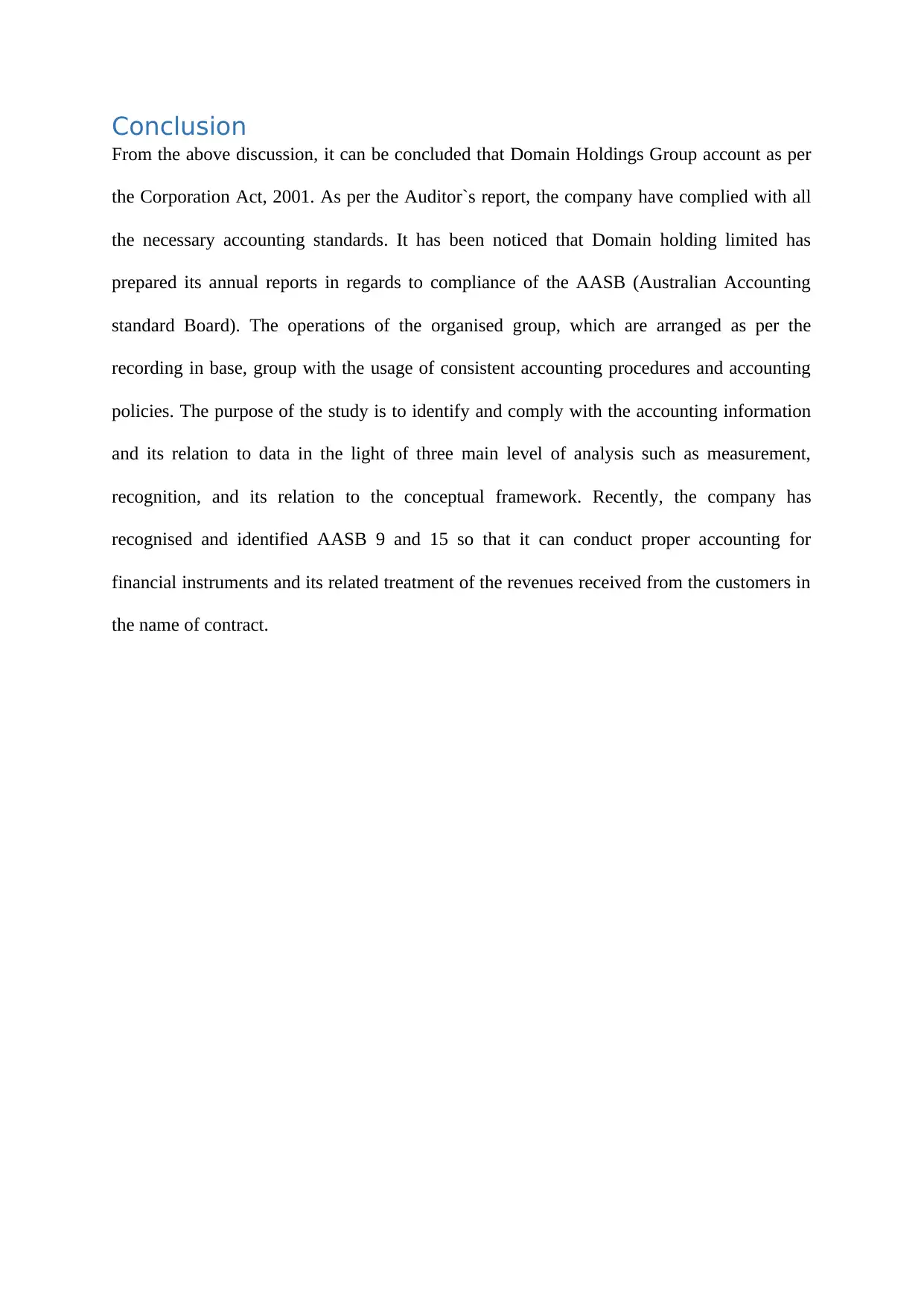
Conclusion
From the above discussion, it can be concluded that Domain Holdings Group account as per
the Corporation Act, 2001. As per the Auditor`s report, the company have complied with all
the necessary accounting standards. It has been noticed that Domain holding limited has
prepared its annual reports in regards to compliance of the AASB (Australian Accounting
standard Board). The operations of the organised group, which are arranged as per the
recording in base, group with the usage of consistent accounting procedures and accounting
policies. The purpose of the study is to identify and comply with the accounting information
and its relation to data in the light of three main level of analysis such as measurement,
recognition, and its relation to the conceptual framework. Recently, the company has
recognised and identified AASB 9 and 15 so that it can conduct proper accounting for
financial instruments and its related treatment of the revenues received from the customers in
the name of contract.
From the above discussion, it can be concluded that Domain Holdings Group account as per
the Corporation Act, 2001. As per the Auditor`s report, the company have complied with all
the necessary accounting standards. It has been noticed that Domain holding limited has
prepared its annual reports in regards to compliance of the AASB (Australian Accounting
standard Board). The operations of the organised group, which are arranged as per the
recording in base, group with the usage of consistent accounting procedures and accounting
policies. The purpose of the study is to identify and comply with the accounting information
and its relation to data in the light of three main level of analysis such as measurement,
recognition, and its relation to the conceptual framework. Recently, the company has
recognised and identified AASB 9 and 15 so that it can conduct proper accounting for
financial instruments and its related treatment of the revenues received from the customers in
the name of contract.
⊘ This is a preview!⊘
Do you want full access?
Subscribe today to unlock all pages.

Trusted by 1+ million students worldwide
1 out of 14
Related Documents
Your All-in-One AI-Powered Toolkit for Academic Success.
+13062052269
info@desklib.com
Available 24*7 on WhatsApp / Email
![[object Object]](/_next/static/media/star-bottom.7253800d.svg)
Unlock your academic potential
Copyright © 2020–2025 A2Z Services. All Rights Reserved. Developed and managed by ZUCOL.





